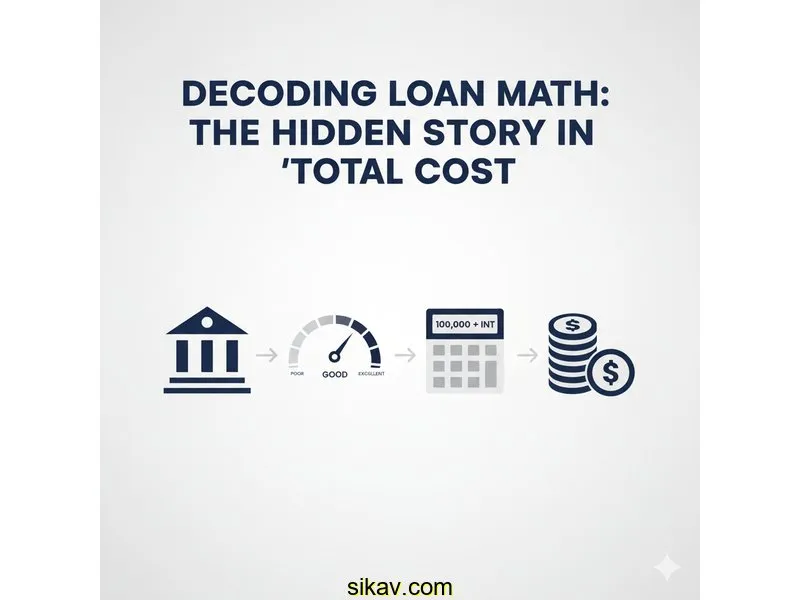
Auto Loan Calculator
Calculate payments over the life of your Loan
Home Blog Privacy Terms About Contact
Calculate payments over the life of your Loan
Home Blog Privacy Terms About ContactPublished on October 14, 2025

For the longest time, I thought I understood the basics of borrowing money. You get a loan, you pay it back each month, and eventually, it's gone. The most important number, in my mind, was the monthly payment. If I could afford that number, everything else was just details. It was a simple, comfortable way to look at things, but I soon discovered it was like trying to understand a novel by only reading the first sentence of each chapter.
My learning journey started with a simple conversation. A friend was talking about a hypothetical loan they were considering, and the monthly payment they mentioned was surprisingly low. It was for a similar amount to what I had been running numbers for in my own financial literacy exercises, but their payment was almost a hundred dollars less. My immediate thought was, "Wow, they must have gotten an amazing interest rate!" But when we compared the hypothetical rates, they were identical. How was that possible? How could two loans for the same amount at the same rate have such different monthly payments?
This simple question sent me down a rabbit hole. I fired up my browser and started plugging numbers into online loan calculators, determined to solve the puzzle. I wasn't looking to make a financial decision; I was genuinely curious about the math itself. I wanted to understand the mechanics behind the numbers that shape so much of our financial lives. What invisible lever was being pulled that made one payment so much lower than another?
This article is the story of that discovery. It's about peeling back the layers of a loan calculation to understand the full picture. It's not financial advice, but a chronicle of my personal "aha!" moment in learning how the numbers truly work. It's about my journey from focusing on a single number to understanding the entire financial story it was a part of.
My investigation began with two specific scenarios. I wanted to create an apples-to-apples comparison to isolate the variable that was confusing me. So, I imagined two people taking out the exact same loan amount—let's say $14,850—at the exact same interest rate, which I set at 7.2%. In my head, this meant their monthly payments should be identical. Obviously, I was wrong.
I replicated my scenario in an online calculator first. For my hypothetical loan, I entered a term of 48 months (4 years). The calculator spit out a monthly payment of about $360.29. Then, I plugged in the numbers for my friend's hypothetical situation. I kept the loan amount and interest rate the same, but I remembered they had mentioned a longer repayment period. I entered a term of 72 months (6 years). The result was a monthly payment of about $256.03.
There it was, in black and white. The lower payment was real. For a moment, I felt like I was missing something obvious. A lower payment just seemed better, full stop. It's less money coming out of your budget each month. But my curiosity wouldn't let it go. Most good loan calculators have more fields than just the monthly payment. I noticed two others: "Total Principal Paid" and "Total Interest Paid." This is where things started to unravel my simple understanding.
For the 48-month scenario, the calculator showed:
For the 72-month scenario, it showed:
I stared at the screen for a solid minute. The "cheaper" monthly payment resulted in over $1,140 more in total interest. The total cost was significantly higher! It felt completely counterintuitive. How could paying less each month lead to paying so much more overall? My brain was stuck on the monthly figure, the number that felt most immediate and tangible. I had been so focused on the affordability of the single payment that I had completely ignored the cumulative cost over the entire life of the loan. I realized my mistake wasn't in the math, but in what I was choosing to look at.

The breakthrough came when I stopped thinking about a loan as just a monthly bill and started seeing it as a complete system with interconnected parts. The monthly payment, the interest rate, and the loan term aren't independent numbers; they're locked in a mathematical dance. Change one, and the others have to adjust. My mistake was only watching one of the dancers.
To really get it, I had to physically write it down. I wasn't just relying on the calculator's output anymore; I was trying to understand the simple logic behind it. For the first loan, I multiplied the monthly payment by the number of months: $360.29 x 48 months. For the second, I did the same: $256.03 x 72 months. Seeing those two totals—$17,293.92 and $18,434.16—side-by-side was the visual proof I needed. The extra 24 payments, even though they were smaller, added up to a much larger sum over time. The calculator wasn't magic; it was just doing this basic, yet powerful, multiplication for me.
My key learning was realizing that the loan term is arguably one of the most powerful variables in the entire calculation. Extending the term is the easiest way to lower the monthly payment because you're slicing the same amount of money (plus interest) into more, smaller pieces. The catch is that by extending the timeline, you are renting the bank's money for longer. And just like renting anything, the longer you use it, the more you pay in total.
To truly cement this, I clicked the "Show Amortization Schedule" button on the calculator. For the 48-month loan, I could see my principal balance decreasing at a steady rate. For the 72-month loan, the principal went down much, much more slowly, especially in the early years. So much more of that smaller payment was being eaten up by interest each month. The schedule provided a clear, visual story of how a longer loan keeps you paying interest for a greater period, delaying significant progress on the principal you actually borrowed.
Feeling more confident, I decided to test my newfound knowledge with a completely different scenario. I imagined a $19,200 loan at a 6.8% interest rate. First, I calculated it for a 60-month (5-year) term. The payment was about $379.54, with total interest of $3,572.40. Then, I stretched it to an 84-month (7-year) term. The payment dropped to $286.07, but the total interest ballooned to $5,029.88. The pattern held. The lower monthly payment came at the cost of nearly $1,500 in extra interest. I finally got it. The monthly payment tells you what you can afford right now; the total cost tells you what you're actually paying for that affordability.
This whole experience was a huge step forward in my financial literacy journey. It was like learning a new language. I used to see a loan offer and my eyes would go straight to one number. Now, I see a set of interconnected data points that tell a complete story. Here are the core lessons I took away about the calculations themselves:
The loan term directly impacts the number of times interest is calculated on your outstanding balance. With a longer term, even though your principal is decreasing, it does so more slowly. This means you have a higher average balance over a longer period, giving the interest more time and a larger base to accumulate against.
Not necessarily. It's a tool for managing monthly cash flow. The key is understanding the trade-off. A calculation that results in a lower payment via a longer term also results in a higher total cost. Understanding this mathematical relationship is what matters, so you can see both sides of the coin: short-term affordability versus long-term cost.
From my experience, the best method is to keep the loan amount and interest rate constant and only change the term. Create a simple table comparing a short term (e.g., 36 months), a medium term (e.g., 60 months), and a long term (e.g., 84 months). Record the monthly payment and the total interest paid for each. This exercise will quickly and clearly show you the mathematical relationship between time and money.
I think it's human nature to focus on the most immediate pain point, which is the monthly budget. The monthly payment feels real and urgent, while the "total cost" feels distant and abstract. Learning to shift my focus from the immediate number to the long-term one was the biggest step in my financial calculation literacy.
My journey to solve this simple puzzle taught me something profound: financial literacy isn't about finding secret tricks or loopholes. It's about taking the time to understand the fundamental math that governs these financial products. The answers were never hidden; they were right there in the output of the calculator. I just didn't know which questions to ask or which numbers to look at.
My biggest takeaway is that the monthly payment and the total cost tell two different but equally important stories. One is about immediate affordability, and the other is about long-term expense. Learning to listen to both stories is the real key to understanding the full picture of a loan. I now feel so much more confident in my ability to look at a set of loan numbers and understand not just what I would pay, but how and why.
I encourage anyone who feels intimidated by these calculations to simply start playing with an online calculator. Change the numbers, ask "what if," and watch how the results change. You're not making a commitment; you're just educating yourself. And that knowledge is incredibly empowering.
This article is about understanding calculations and using tools. For financial decisions, always consult a qualified financial professional.
Disclaimer: This article documents my personal journey learning about loan calculations and how to use financial calculators. This is educational content about understanding math and using tools—not financial advice. Actual loan terms, rates, and costs vary based on individual circumstances, creditworthiness, and lender policies. Calculator results are estimates for educational purposes. Always verify calculations with your lender and consult a qualified financial advisor before making any financial decisions.
About the Author: Written by Alex, someone who spent considerable time learning to understand personal finance calculations and use online financial tools effectively. I'm not a financial advisor, accountant, or loan officer—just someone passionate about financial literacy and helping others understand how the math works. This content is for educational purposes only.